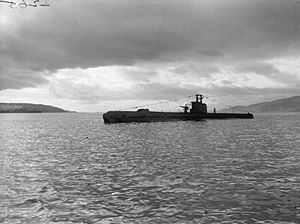Name HMS Sea Nymph Commissioned 3 November 1942 Launched 29 July 1942 Test depth 91 m | Laid down 6 May 1941 Fate broken up, 1948 Construction started 6 May 1941 Length 66 m Draft 4.47 m | |
 | ||
Displacement 842 long tons (856 t) surfaced990 long tons (1,010 t) submerged | ||
HMS Sea Nymphe was a S-class submarine of the third batch built for the Royal Navy during World War II. She survived the war and was scrapped in 1948.
Contents
Design and description
The third batch was slightly enlarged and improved over the preceding second batch of the S-class. The submarines had a length of 217 feet (66.1 m) overall, a beam of 23 feet 9 inches (7.2 m) and a draft of 14 feet 8 inches (4.5 m). They displaced 842 long tons (856 t) on the surface and 990 long tons (1,010 t) submerged. The S-class submarines had a crew of 48 officers and ratings. They had a diving depth of 300 feet (91.4 m).
For surface running, the boats were powered by two 950-brake-horsepower (708 kW) diesel engines, each driving one propeller shaft. When submerged each propeller was driven by a 650-horsepower (485 kW) electric motor. They could reach 15 knots (28 km/h; 17 mph) on the surface and 10 knots (19 km/h; 12 mph) underwater. On the surface, the third batch boats had a range of 6,000 nautical miles (11,000 km; 6,900 mi) at 10 knots (19 km/h; 12 mph) and 120 nmi (220 km; 140 mi) at 3 knots (5.6 km/h; 3.5 mph) submerged.
The boats were armed with seven 21-inch torpedo tubes. A half-dozen of these were in the bow and there was one external tube in the stern. They carried six reload torpedoes for the bow tubes for a grand total of thirteen torpedoes. Twelve mines could be carried in lieu of the internally stowed torpedoes. They were also armed with a 3-inch (76 mm) deck gun.
Construction and career
HMS Sea Nymph was built by Cammell Laird and launched on July 29, 1942. She spent most of the Second World War in home waters off the Scandinavian Coast, where she made a number of unsuccessful attacks on enemy shipping, including the German submarine U-592, the Norwegian merchant Jupiter and the German merchant Levante. All torpedoes fired missed their targets. Sea Nymph survived the war and was eventually sold. She arrived at Troon in June 1948 for breaking up.
